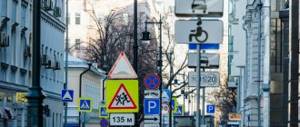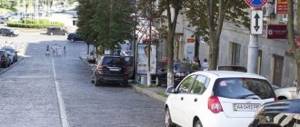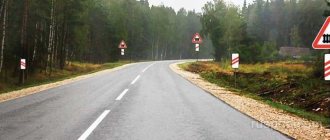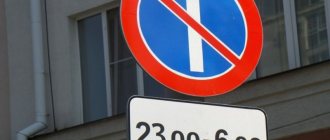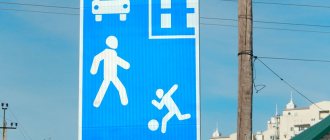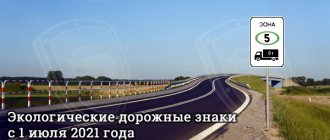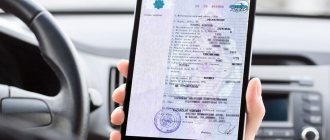Purpose
The purpose of these signs is quite varied and it is very difficult to define them unambiguously. There is even an opinion that this group includes signs that were not included in other groups.
However, there is a definition and it is formulated in the traffic rules:
Signs of special requirements are intended to introduce or cancel certain traffic modes.
They introduce or cancel restrictions, inform the driver about driving modes and can combine several instructions at once.
Why are special warning signs used?
It may seem that to ensure order on the road and safety on the roadway, the existing signs are sufficient.
After all, they explain in more than detail the rules of behavior for the driver. However, in some cases, to communicate what is possible and what is not, you will have to put up a lot of signs with descriptions. An example is a motorway.
On this section of the road it is strictly prohibited:
- stop;
- perform turns;
- pedestrians are not allowed to appear on the highway;
- cyclists are prohibited;
- Horse-drawn vehicles are also not allowed on the highway.
At the same time, on this section of the road it is allowed to drive at a speed of 110 km/h. If a separate sign was placed on all these prohibitions and permissions, then the entire road would be lined with them.
Therefore, road services came to the conclusion that it is necessary to put up only one sign indicating that the driver is within the highway. In the traffic rules, make a detailed description of permitted and prohibited actions on a specified section of the road.
The same applies to the roadway of a city, village, village. A corresponding sign is placed with a decoding in the traffic rules. After all, movement is also limited here and certain types of maneuvers are allowed.
This form of warning drivers about a special section of the roadway is called special road signs.
For each sign in the traffic rules there is a description of what is included in its area of action. Permitted maneuvers and prohibitions are listed.
Detailed description with explanations
Tells the driver to start driving on the highway. By default, passenger cars are allowed to travel at a speed of no more than 110 km/h. In order to ensure such a high speed, certain design solutions are used on highways:
- The presence of a dividing strip, which practically eliminates head-on collisions of oncoming vehicles.
- There are no intersections at the same level with roads, railways and tram tracks, as well as the absence of surface pedestrian crossings.
A number of restrictions are also introduced:
By the way, a highway is a sign with a green background, and if you see a green background on other road signs, for example, on information ones (such as the name of an object, an indicator of distances and directions), then the road to these objects will pass along the highway.
Sign 5.2 informs the driver about the end of the highway, which means a reduction in the speed limit and the abolition of the restrictions described above.
Designed only for the movement of cars, buses and motorcycles.
The presence of a dividing strip is not regulated here, so the maximum speed is limited to 90 km/h. But all other prohibitions and restrictions are exactly the same as when driving on highways.
5.4 warns of the end of the road for cars.
The movement of all vehicles along the entire width of the roadway is carried out in one direction. I would like to draw your attention to the fact that stopping and parking on such roads for passenger cars and trucks with a maximum permitted weight of up to 3.5 tons is permitted on both the left and right sides of the road. Reversing is also not prohibited. 5.6 speaks of the end of the road, where one-way traffic is organized.
Installed before exiting or crossing a one-way road. The direction of the arrow on the sign corresponds to the direction of traffic flow. In fact, the signs prohibit turning in the direction opposite to the arrow. But under no circumstances is it prohibited to turn around.
The beginning and end of a road with reverse traffic. Tells the driver that the direction of movement in one or more lanes, depending on the situation (time of day, day of the week, etc.) may change to the opposite.
Reversible lanes are indicated by a double broken line marking. And it is prohibited to drive onto them without seeing a reverse traffic light signal.
Drive out onto a road where reverse traffic is organized. The principle is the same as what I described earlier: without seeing a reversible traffic light signal, you cannot turn into reversible lanes (marked by markings).
The beginning and end of the road, with a dedicated lane for route vehicles moving towards the general traffic flow. Entering this lane is strictly prohibited and is equivalent to entering oncoming traffic.
The beginning and end of the road, with a dedicated lane for cyclists and moped riders who are moving towards the general traffic flow.
It is installed before entering the road, where there is a lane for route vehicles moving towards the main traffic flow. Turning into this lane, as well as driving along it, is prohibited. Turning around at such intersections is not prohibited!
Informs the driver about an intersection with a road where there is a dedicated lane for bicycles and mopeds. Like the previous sign, it is prohibited to turn into this lane.
Tells the driver about the beginning/end of the lane for route vehicles. Moreover, in this case, the lane is favorable. If the sign is supplemented with a “traffic lane” sign, then the lane to which the arrow points is allocated for route vehicles. If there is no such sign, then no matter where the sign is installed (on the left or right of the road, above the road), the lane for route vehicles is the far right.
Now is the time to decide whether you can occupy it?
There are two scenarios here:
- this lane is separated from the rest of the roadway by a continuous marking line. In this case, under no circumstances can you drive onto it;
- the strip is separated by a broken marking line. Traffic on it is prohibited. But before turning left, we must first change lanes to it (using it as a braking area), and when entering a road with a lane for route vehicles, first take this lane, using it as an acceleration lane. Beginning/end of the lane for bicycles and mopeds. Other t.s. they cannot use it.
The situation is similar with the lane for cyclists and moped drivers; other vehicles cannot occupy it.
Indicates the number of lanes and the permitted directions of movement along them. Can be installed both above the roadway and to the left/right of it. Only route vehicles can deviate from the requirements.
Indicates possible driving directions for each lane. Unlike previous signs, signs in this series are installed above each lane. They are placed in advance so that the driver can take the position necessary for a particular maneuver in advance.
Informs the driver about the presence of an additional passing lane for traffic, and indicates which side it will appear on. On the sign you can find additional instructions, for example: restrictions for certain categories of vehicles. or minimum speed limit.
Notifies the driver about the end of the lane and the need to change lanes soon.
Shows the driver the number of lanes on the roadway and the restrictions that apply to each of them.
Not only a bus stop, but also a trolleybus stop. Stopping and parking closer than 15 meters is prohibited. If there is a marking, then we take the distance from the yellow zigzag line, if there is no marking, then from this sign. An exception is stopping to pick up/drop off passengers, but the driver must not interfere with buses and trolleybuses. And also give way to route vehicles leaving the stopping place.
Tram stop location. Very often the tram stops in the middle of the roadway and the paths of pedestrians walking towards the tram and cars intersect. In this case, pedestrians, or passengers, who are on the side of the tram doors, have priority over cars, that is, the driver must let them through.
This is how taxi parking areas are designated.
Regardless of whether there is a zebra marking or not, this sign indicates a pedestrian crossing. The boundaries of a pedestrian crossing are considered to be the distance between two such signs installed on different sides of the road.
Indicates the front (closest to the driver) boundary of the artificial hump. When this sign is detected, the driver is advised to reduce speed in advance.
The beginning and end of the residential area. Here pedestrians have priority over cars over the entire width of the roadway. Certain restrictions are introduced in the area of the sign:
- through traffic ban
- training ride
- parking with engine running
- permitted speed no more than 20 km/h
- parking of trucks (with a permissible weight of more than 3.5 tons) outside specially designated areas
A sign on a white background means that the driver is entering a populated area. And accordingly, all rules for movement within the boundaries of a populated area come into force:
- speed limit 60 km/h
- restriction on sound signal (except for accident prevention), etc.
This sign informs the driver about the presence of a populated area, but since it is located somewhat to the side and the driver does not pass through it, the rules for driving in a populated area do not apply here.
Signs of special regulations
Special regulations signs introduce or cancel certain traffic modes. 5.1 "Highway". A road on which the requirements of the Road Traffic Rules of the Russian Federation apply, establishing the procedure for driving on highways. (a comment)
5.2 "End of the motorway." (a comment)
5.3 “Road for cars.” A road intended for use only by cars, buses and motorcycles. (a comment)
5.4 “The end of the road for cars.” (a comment)
5.5 “One-way road.” A road or carriageway along which vehicle traffic across its entire width is carried out in one direction. (a comment)
5.6 "The end of a one-way road." (a comment)
5.7.1 “Entering a one-way road.” Entering a one-way road or carriageway. (a comment)
5.7.2 “Entering a one-way road.” (a comment)
5.8 "Reverse movement". The beginning of a section of road where one or more lanes may change direction to the opposite direction. (a comment)
5.9 “End of reverse movement.” (a comment)
5.10 “Entering a road with reverse traffic.” (a comment)
5.11.1 "Dedicated lane for route vehicles." This sign indicates a section of the roadway on which there is a separate lane intended for route vehicles. Movement on it is carried out against the main flow of traffic. (a comment)
5.11.2 "Road with a lane for cyclists." This sign indicates that in addition to vehicle lanes, there is a bicycle path. Cyclists move along the roadway towards the general traffic of cars. (a comment)
5.12.1 “End of a road with a lane for route vehicles.” (a comment)
5.12.2 “End of the roadway with a lane for cyclists.”
Sign 5.12.1 shows the end of the road with a separate roadway for people traveling by bicycle. Installation is carried out at the very end of the roadway. (comment)
5.13.1 “Entering a road with a lane for route vehicles.” (a comment)
5.13.2 “Entering a road with a lane for route vehicles.” (a comment)
5.13.3 “Entering a road with a path for bicycles and mopeds.” (a comment)
5.13.4 “Exit onto a road with a path for bicycles and mopeds.” (a comment)
5.14 “Lane for route vehicles.” A lane intended for the movement of route vehicles only and vehicles used as passenger taxis moving in the same direction as the general flow of vehicles. (a comment)
The effect of the sign extends to the strip above which it is located. The effect of a sign installed on the right of the road extends to the right lane.
5.14 D “Separate lane for trams.” The lane is intended exclusively for the movement of trams. Place a sign in front of the tram tracks along with markings 1.1 or 1.2. (a comment)
5.14.1 “End of lane for route vehicles.” (a comment)
5.14.1 D “Direction of public transport”. These designations indicate the impossibility of public transport moving in a straight line on a cross road surface. You need to turn right. (a comment)
5.14.2 “Bicycle lane”. Category – special requirements. This design can be found at the beginning of a separate lane on a road intended exclusively for the movement of bicycles and mopeds. (a comment)
5.14.2 D “Direction of public transport”. The sign indicates that it is impossible for public transport to move in a straight line on an intersection road surface and instructs you to turn left. (a comment)
5.14.3 “End of the bicycle zone.” The sign indicates to people riding mopeds and bicycles that their lane has ended. (a comment)
5.14.3 D “Public transport lane.” The sign shows that when crossing a perpendicular road surface, public transport will not be able to move straight. You need to turn around. (a comment)
5.15.1 “Traffic directions along lanes.” The number of lanes and permitted directions of movement for each of them. (a comment)
5.15.2 “Lane directions”. Permitted lane directions. (a comment)
Signs 5.15.1 and 5.15.2, which permit a left turn from the extreme left lane, also permit a U-turn from this lane.
Signs 5.15.1 and 5.15.2 do not apply to route vehicles.
The effect of signs 5.15.1 and 5.15.2 installed in front of the intersection applies to the entire intersection, unless other signs 5.15.1 and 5.15.2 installed on it give other instructions. 5.15.3 “Start of stripe”. The beginning of an additional uphill or braking lane. (a comment)
If the sign installed in front of the additional lane displays sign(s) 4.6 “Minimum speed limit,” then the driver of a vehicle who cannot continue driving along the main lane at the indicated or higher speed must change lanes to the lane located to his right. 5.15.4 “Start of stripe”. The beginning of the middle section of a three-lane road intended for traffic in a given direction. If sign 5.15.4 shows a sign prohibiting the movement of any vehicles, then the movement of these vehicles in the corresponding lane is prohibited. (a comment)
5.15.5 “End of lane”. The end of an additional uphill lane or acceleration lane. (a comment)
5.15.6 “End of lane”. The end of a section of the median on a three-lane road intended for traffic in a given direction. (a comment)
5.15.7 “Direction of traffic along the lanes.” (a comment)
If sign 5.15.7 shows a sign prohibiting the movement of any vehicles, then the movement of these vehicles in the corresponding lane is prohibited.
Signs 5.15.7 with the appropriate number of arrows can be used on roads with four or more lanes. 5.15.8 “Number of lanes”. Indicates the number of lanes and lane modes. The driver is obliged to comply with the requirements of the signs marked on the arrows. (a comment)
5.15.1 D “Direction of traffic along the lanes.” (a comment)
5.15.2 D “Directions of traffic along the lanes.” (a comment)
5.15.3 D “Start of maneuver lane.” (a comment)
5.15.4 D “Start of additional traffic lanes.” (a comment)
5.15.5 D “Narrowing of the road to the left.” (a comment)
5.15.6 D “Narrowing of the road to the right.” (a comment)
5.15.7 D “Direction of traffic along lanes when changing lanes.” (a comment)
5.15.8 D “Number of lanes and changing lanes onto a parallel road.” (a comment)
5.15.9 D “End of parallel road.” (a comment)
5.15.10 D “End of the parallel carriageway.” (a comment)
5.15.11 D “Merge of parallel routes.” (a comment)
5.16 “Bus and (or) trolleybus stopping place.” (a comment)
5.16 D “Joint public transport stop sign with route description” (commentary)
5.17 “Tram stopping place.” (a comment)
5.18 “Taxi parking area.” (a comment)
5.19.1 “Pedestrian crossing”. (a comment)
5.19.1 D "Pedestrian crossing". (a comment)
5.19.2 “Pedestrian crossing”. (a comment)
5.19.2 D "Pedestrian crossing". (a comment)
If there are no markings 1.14.1 or 1.14.2 at the crossing, sign 5.19.1 is installed to the right of the road on the near border of the crossing relative to approaching vehicles, and sign 5.19.2 is installed to the left of the road on the far border of the crossing.
5.19.3 “Diagonal pedestrian crossing.” (a comment)
5.19.4 “Diagonal pedestrian crossing.” (a comment)
5.20 “Artificial hump”. Indicates the boundaries of an artificial roughness. (a comment)
The sign is installed at the nearest boundary of the artificial hump relative to approaching vehicles. 5.21 “Residential area”. The territory in which the requirements of the Road Traffic Rules of the Russian Federation are in force, establishing the rules of traffic in a residential area. (a comment)
5.22 “End of the residential area.” (a comment)
5.23.1 “Beginning of a settlement.” The beginning of a populated area in which the requirements of the Road Traffic Rules of the Russian Federation are in force, establishing the procedure for traffic in populated areas. (a comment)
5.23.2 “Beginning of a settlement.” The beginning of a populated area in which the requirements of the Road Traffic Rules of the Russian Federation are in force, establishing the procedure for traffic in populated areas. (a comment)
5.24.1 “End of a populated area.” The place from which on a given road the requirements of the Road Traffic Rules of the Russian Federation, establishing the procedure for traffic in populated areas, cease to apply. (a comment)
5.24.2 “End of a populated area.” The place from which on a given road the requirements of the Road Traffic Rules of the Russian Federation, establishing the procedure for traffic in populated areas, cease to apply. (a comment)
5.25 “The beginning of a settlement.” The beginning of a populated area in which the requirements of the Road Traffic Rules of the Russian Federation, which establish traffic rules in populated areas, do not apply on this road. (a comment)
5.26 “End of a settlement.” The end of the settlement indicated by sign 5.25. (a comment)
5.27 “Zone with limited parking.” The place from which the territory (section of the road) begins where parking is prohibited. (a comment)
5.28 “End of restricted parking zone.” (a comment)
5.29 “Regulated parking zone.” The place from which the territory (section of the road) begins, where parking is permitted and regulated with the help of signs and markings. (a comment)
5.30 “End of regulated parking zone.” (a comment)
5.31 “Zone with maximum speed limit.” The place from which the territory (section of the road) begins where the maximum speed is limited. (a comment)
5.32 “End of zone with maximum speed limit.” (a comment)
5.33 “Pedestrian zone”. (a comment)
5.33.1 “Bicycle zone”. (a comment)
5.34 “End of the pedestrian zone.” (a comment)
5.34.1 “End of the pedestrian zone.” (a comment)
5.35 “Zone with restrictions on the environmental class of motor vehicles.” (a comment)
5.36 “Zone with restrictions on the environmental class of trucks.” (a comment)
5.37 “End of the zone with restrictions on the environmental class of motor vehicles.” (a comment)
5.37d "Zone of joint movement on foot and by bicycle." (a comment)
5.38 “End of the zone with restrictions on the environmental class of trucks.” (a comment)
5.38d “End of the zone for joint movement of pedestrians and cyclists.” (a comment)
- Appendix 1. Road signs :1. Warning signs2. Priority signs3. Prohibition signs4. Mandatory signs 5. Signs of special requirements 6. Information signs7. Service marks8. Additional information signs (plates)
For each sign there is an additional description. Just follow the link on the sign. Ask all questions in the comments on the website www.autoass.ru
The content of the article:
- signs of special regulations
- signs
- special regulations signs
- signs of special regulations explanation of what they are? what are comments for?


